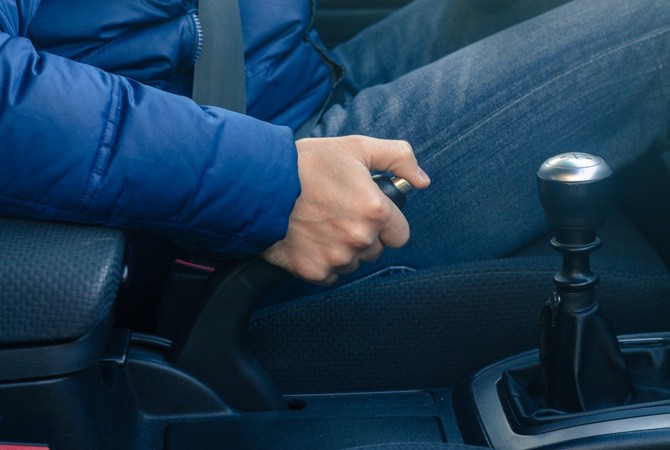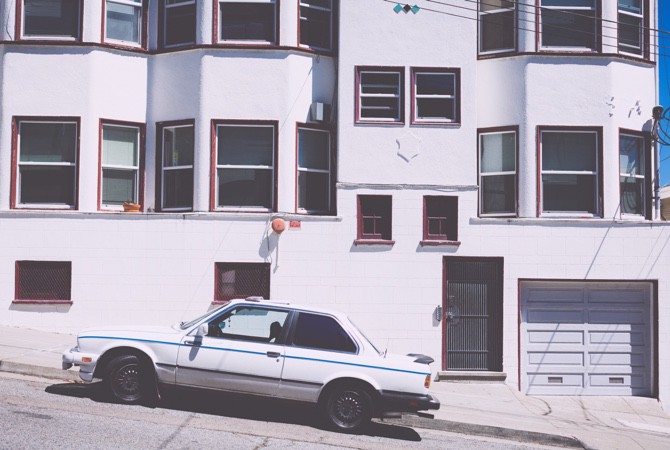IN CASE OF EMERGENCY…

Having to park your vehicle on a hill can be nerve wracking. Will your car be there when you return? Will it roll away? This isn’t something you want to leave to chance – you don’t want your vehicle to potentially be a danger to others.
Did you know that your vehicle is equipped with a safety system that, when activated, can help keep your vehicle in place? Read on to learn about your vehicle’s emergency brake and when it should be used.
WHAT IS THE EMERGENCY BRAKE?

Part of your vehicle’s brake system, the emergency brake operates independently of the main brake system to keep your vehicle from rolling away. Also known as a parking brake, hand brake and e-brake, the emergency brake was originally designed to be used if the vehicle’s main braking system would fail.
However, in today’s vehicles, the parking brake doesn’t have enough stopping power to bring the car to a halt. The parking brake now is mainly used to keep the vehicle in place when parked.
HOW DOES THE E-BRAKE WORK?
The emergency brake bypasses your vehicle’s hydraulic brake system to lock the wheels in place. This mechanical system uses cables that are attached to the emergency brake lever. When engaged on cars with drum brakes, the cables pull another lever that puts pressure on the brake shoes to hold the vehicle.
On cars with disc brakes, applying the parking brake activates a corkscrew mechanism that pushes a piston into the brake pads to stop the vehicle.
TYPES OF PARKING BRAKES
There are four main types of parking brakes that you may encounter:
Pedal – The pedal emergency brake is a small pedal that is positioned on the floor and to the left of the gas, brake and clutch pedals. Press down on the pedal until you hear it click to engage it. Pull the lever above the foot pedal to release the brake.
Center lever – Popular on late-model vehicles with bucket seats, this type of parking brake is found between the seats. Simply pull up the lever to engage the emergency brake. To release the brake, press the button on the end and push down on the stick.
Push button – Located with the other console controls, this typically is an electronic system. Engaging and releasing this type of parking brake is as easy as pushing the button on the console.
Stick lever – Found in many older vehicles, the stick lever emergency brake is commonly found under the instrument panel.
WHEN SHOULD I USE THE PARKING BRAKE?

Many people have the misconception that you only need to use the parking brake if you park on a hill or if your vehicle has a manual transmission. The truth is that you should always use your parking brake. Whether you drive an automatic or a stick shift, or park on a hill or flat spot, using your emergency brake is a good habit to develop.
Using the parking brake on a regular basis helps keep it in proper working order. When you don’t use the emergency brake, it can corrode and you won’t know there is a problem until you really need it.
Engaging the parking brake every time you park helps ensure your vehicle stays securely in place – even on flat surfaces. This extra layer of protection can be especially valuable if your parked vehicle is struck by another car, helping prevent unwanted movement. Using the parking brake also reduces strain on the transmission and driveline components, contributing to long-term reliability.
If you do suffer a complete loss of your brakes, slowly apply the emergency brake. While your parking brake is mainly used to hold your car in place, it can help you safely bring your vehicle to a stop in an emergency situation. Just keep in mind that it won’t bring your vehicle to a sudden stop; it can just help you slowly bring it to a stop.
WHAT HAPPENS IF YOU DRIVE WITH THE EMERGENCY BRAKE ON?
If you’ve ever forgotten to release the parking brake before driving, you're not alone – it’s a common mistake. Still, it’s one to avoid, as driving with the brake engaged can cause excessive wear on brake pads and other components, ultimately reducing braking performance.
WHEN SHOULD I LAY OFF THE EMERGENCY BRAKE?
There is one situation you should never use your hand brake. While it’s fun to watch movies like The Fast & Furious and dream about doing those crazy tricks, leave the stunt driving to the professionals. Never use your hand brake to perform a drift maneuver.
Learn more about quality brake parts, find your car part, or find where to buy your auto part today.
The content contained in this article is for entertainment and informational purposes only and should not be used in lieu of seeking professional advice from a certified technician or mechanic. We encourage you to consult with a certified technician or mechanic if you have specific questions or concerns relating to any of the topics covered herein. Under no circumstances will we be liable for any loss or damage caused by your reliance on any content.